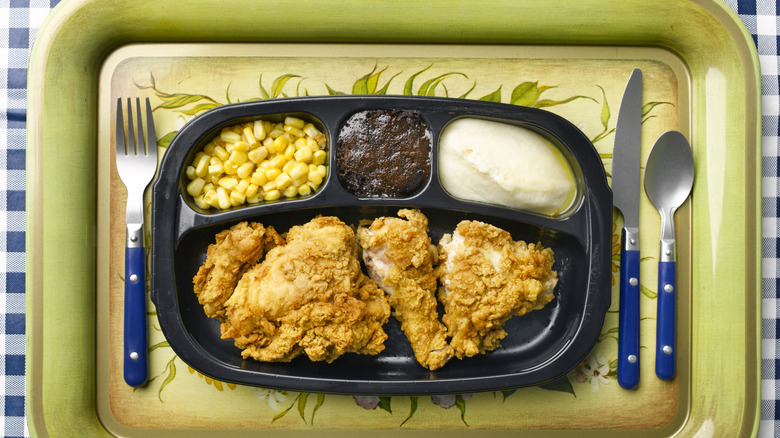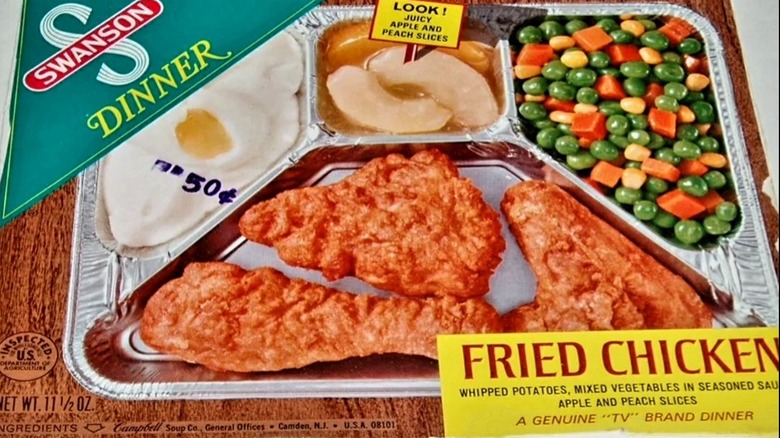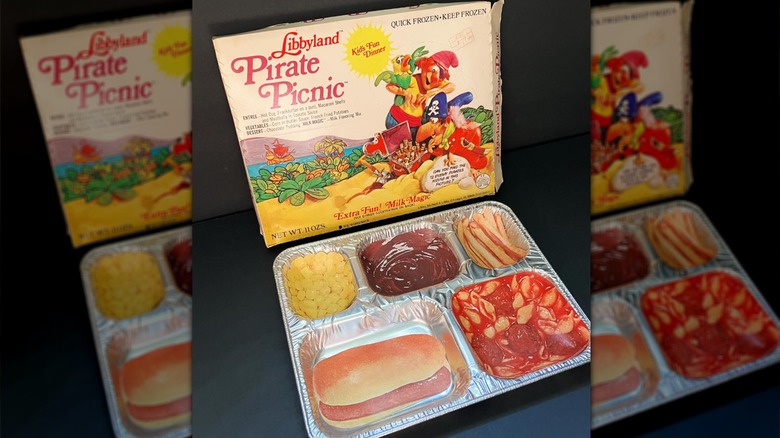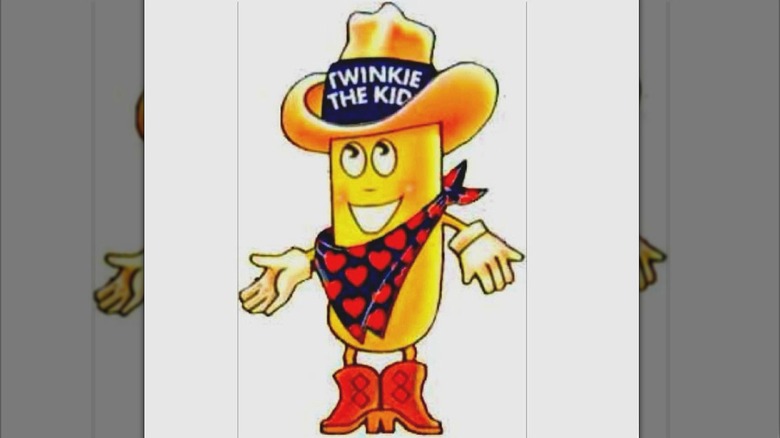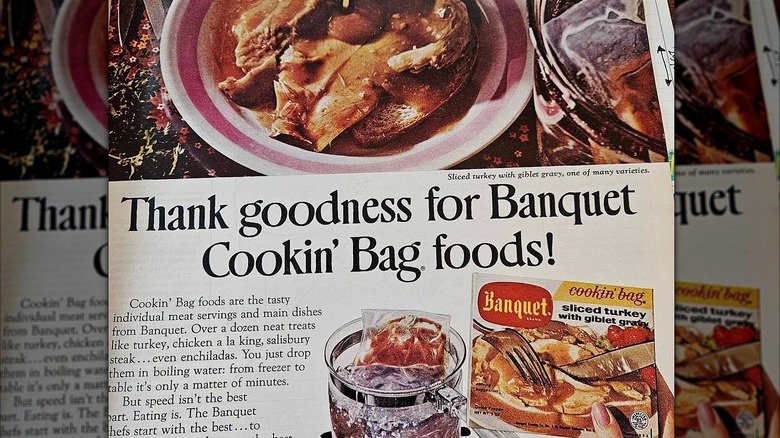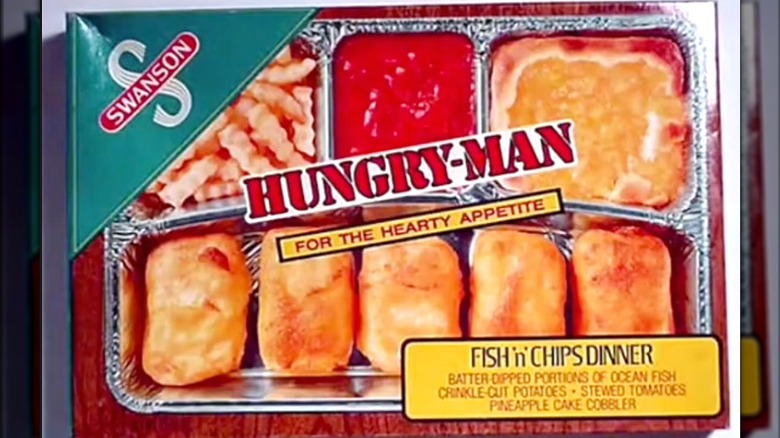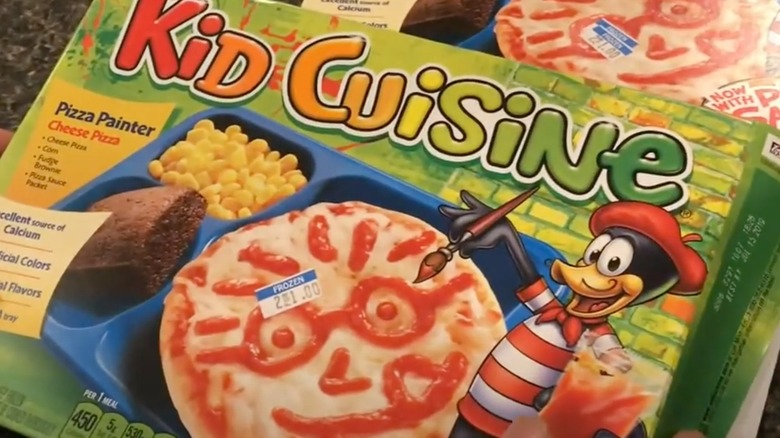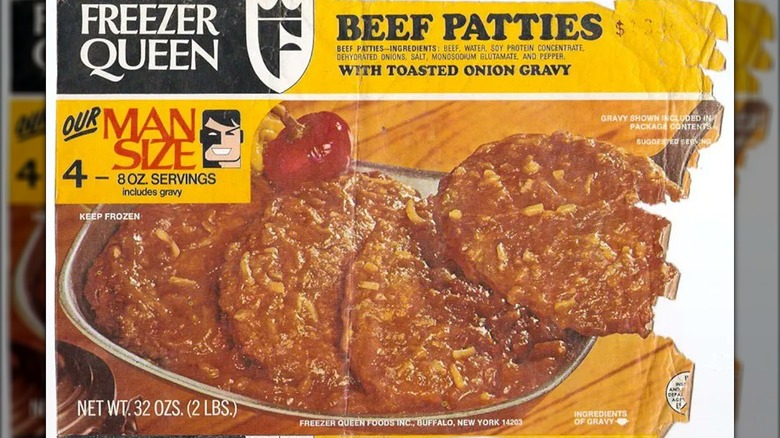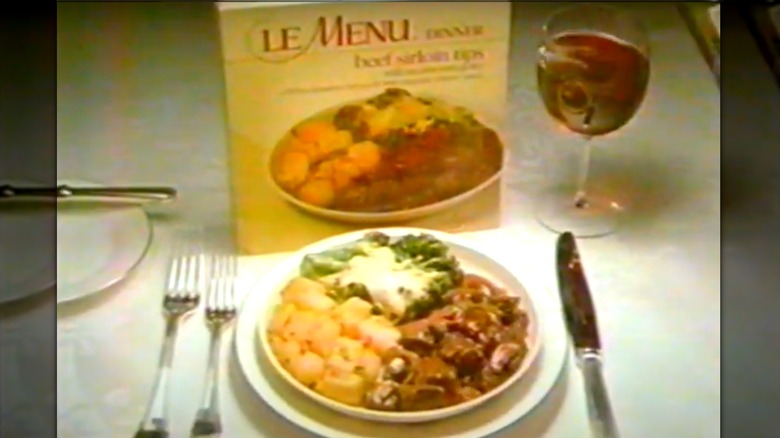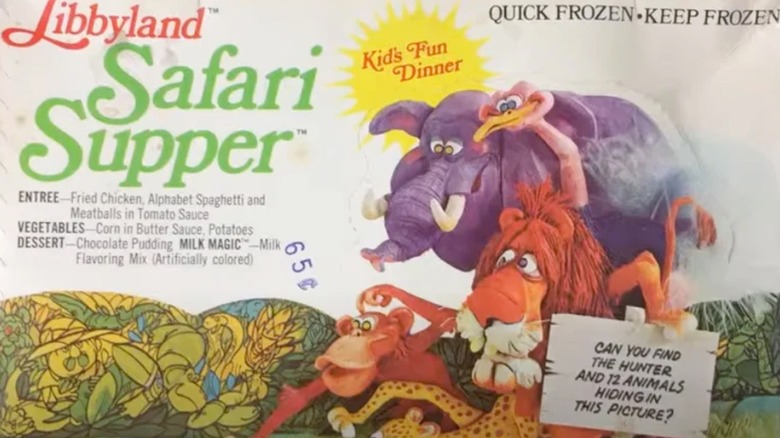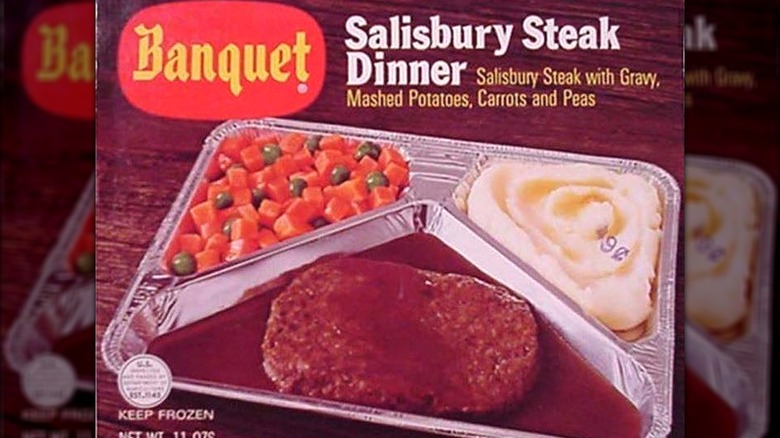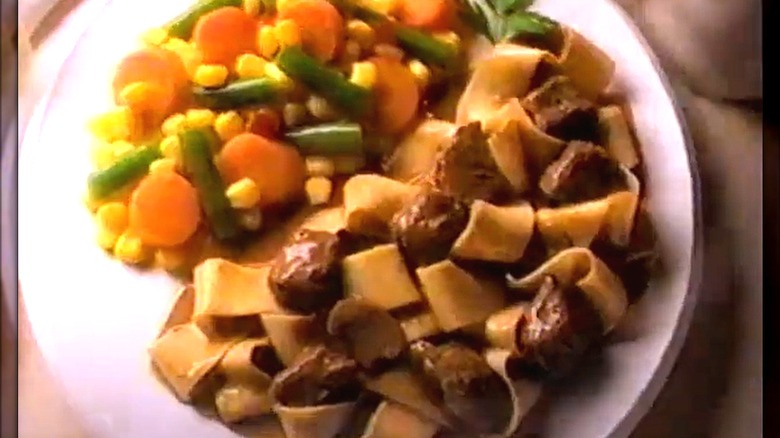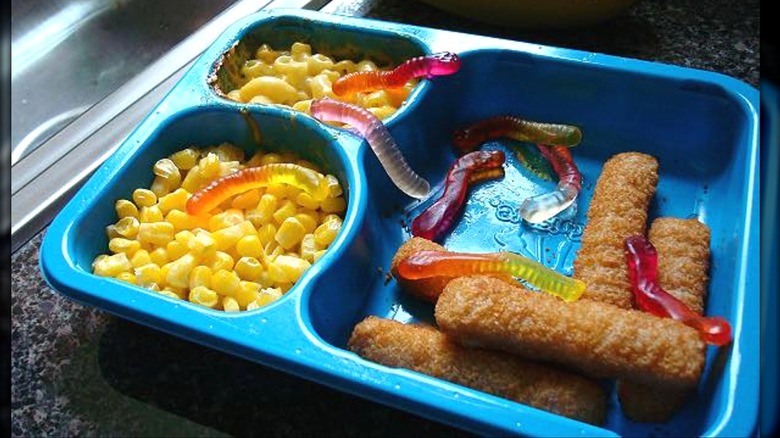Retro TV Dinners That Need To Make A Comeback
TV dinners are such a staple of supermarket cuisine that it's hard to imagine a time when people weren't zapping prepackaged ice-cold meals. The concept was downright revolutionary when it was introduced to American consumers in the early 1950s, even if the military and airlines had already been reheating frozen meals for years. Swanson sold over 10 million of what it coined "TV dinners" in its first full year of sales in the mid-1950s. For less than a buck, you could get a ready-made meal with all the sides separated in their own compartments. No fuss and hardly any cleanup — just heat it and eat it. Some of those OG TV dinners left such an indelible mark on society that we'd love to see them return.
It's no accident that the TV dinner's rise in popularity mirrored that of television. Brands made the containers the perfect size for folding TV tables, and the meals were the ideal companion to tube viewing. As you flipped from "I Love Lucy" to "The Colgate Comedy Hour" in those days, there was a decent chance you'd catch a commercial from a frozen food brand selling the likes of Thanksgiving-style turkey, fried chicken, Mexican enchiladas, or gravy-soaked Salisbury steaks. The earliest TV dinners were slowly chilled and assembled in aluminum trays for oven reheating (faster cryogenic freezing and microwave-safe packaging didn't come until the 1980s). Nevertheless, these retro meals had an old-school charm that was oddly satisfying. We wish some of these TV dinners would make a comeback.
Swanson Fried Chicken Dinner
The executives at Swanson ushered in the TV dinner phenomenon in the mid-1950s when they packaged surplus Thanksgiving turkey along with two sides in an aluminum tray. Widely considered the first mass-produced full frozen meal, it quickly sold past Swanson's initial expectations of 5,000 units. The brand really took off late in the '50s by expanding its offerings to include more options like fried chicken. In its initial run, the Fried Chicken Dinner came with whipped potatoes, along with mixed peas and carrots in the oven-ready tray. Swanson's original marketing campaigns focused on the cringey selling point of wives saving time cooking for their husbands.
The Fried Chicken dinner was popular enough that Swanson continued it into the 1970s and eventually added a third tray compartment for a dessert. Commercials highlighted the meal's value in the era of inflation as well as its "tender crisp" recipe. Those who remember the old chicken dinners claim the crispiness was real enough to rival Colonel Sanders' KFC meals. Much of Swanson's taste factor came down to the 25-minute oven cooking process. These dinners, which came before microwave-safe trays, required you to cut open the foil over the chicken compartment halfway through the cooking process. It was more work, but you got better chicken without ruining the sides.
Libbyland Pirate Picnic
If there's one segment of the population that can appreciate the fun possibilities of TV dinners, it's kids. During the 1970s, Libby's was a pioneer in the frozen dinner market for children with its Libbyland Adventure Dinners that incorporated "the food kids like" with alliterative themes. For the Pirate Picnic, Libbyland served up a hot dog with macaroni and meatballs (later, Sloppy Joes). The box naturally depicted bands of merry buccaneers, no doubt fueled by frankfurters and pudding. When you finished your meal, you'd find a character engraved on the bottom of each tray compartment. Nothing like a hidden aluminum engraving to entice a kid to eat all their lunch.
Libbyland promised parents two meat dishes, two vegetables, and a dessert with each Adventure Dinner. The Pirate Picnic "vegetables" were buttered corn and french fries, so this was far from a healthy meal. But what can you expect when the brand claimed it designed its menu based on what kids told them they liked? Perhaps the best part of the Pirate Picnic was the Milk Magic packet. Kids could sprinkle these sugary crystals into their milk and turn it into a strawberry-flavored treat. Who knows if today's generation would dig it, but many Gen Xers have fond memories of those pirates.
Morton Twinkie Supper
While there have been a lot of uneasy food brand collabs over the years, mixing Twinkies with Morton TV dinners has to be one of the strangest. Morton was a part of the first wave of successful frozen meal brands, releasing fried chicken, meatloaf, and pot pies that competed with Swanson's offerings in the 1960s. However, the product development team went full gimmick mode in the '70s with its Twinkie Supper. They made it sound like the Twinkie was the meal centerpiece, but it was just the dessert offering alongside a more traditional main course, such as a burger or spaghetti. Nevertheless, the audacity of this idea makes it ripe for a kitchy comeback.
What's the benefit of packaging a Twinkie inside a TV dinner versus grabbing a Twinkie separately at the checkout line? Aside from getting a burger- or spaghetti-flavored dessert, customers got a fun cross-promotion between Twinkie and Morton, which were both under the umbrella of ITT Continental Baking Company in the '70s. Advertisements showed that the boxes featured the mascot Twinkie the Kid, a cowboy hat-wearing anthropomorphic Twinkie. This tie-in likely appealed to kids as well as a few adults looking forward to Twinkies for supper. Unfortunately, a comeback is improbable as Morton was later sold to Del Monte and then Conagra before it was discontinued as a TV dinner brand.
Banquet Cookin' Bag Sliced Turkey with Giblet Gravy
When Banquet launched boilable TV dinners in the mid-1950s, they probably thought they had landed on a real game-changer in the frozen food market. Meals like the Sliced Turkey with Giblet Gravy came fully prepared in a plastic bag within the box. All you had to do was throw it in a pot of boiling water for eight minutes, which was less than half the time most of the oven-prepared TV dinners of the day required. The boil-in-a-bag cooking method would evenly reheat while not drying out the food. It was best suited for saucy meats like sliced turkey and gravy, which benefit from a juicier texture.
The boiling process was less effective for entrees like beef with gravy or barbecue sauce that could benefit from a bit of browning or crispiness. While Banquet Cookin' Bag packages would show the meat deliciously sitting on top of toasted bread or buns, these were add-ons that had to be purchased separately and prepared in the toaster. Even though the concept of bag boiling and steaming lives on for veggies, rice, and sauces, it died out for TV dinners as microwaves began entering more kitchens in the 1980s. Nevertheless, it would be nice to see a boilable bag of gravy-soaked turkey come back and add another option in the frozen food aisle.
Swanson Hungry-Man Fish 'N' Chips Dinner
As the '60s gave way to the '70s, Swanson shifted its TV dinner marketing to target more men, specifically hungry men. The Hungry-Man line of frozen dinners launched in 1973 with promises of double-entree helpings and three sides. The Fish 'N' Chips Dinner had a whopping five portions of batter-dipped fish along with crinkle-cut fries, stewed tomatoes, and pineapple cobbler. Sure, the mains contained something called "ocean fish," and the tomatoes looked like cocktail sauce, but it was probably the biggest seafood TV dinner in stores at the time.
Swanson cranked up the bro energy in its Hungry-Man ads, which featured sports stars of the day like Joe Greene and Tommy Lasorda gawking over the amount of meat in each tray. The product line was popular for its large portions at an economical price, but it also played into the tropes of bigger-is-better manliness. While Swanson is no longer in the TV dinner market, Hungry-Man is continuing strong as a standalone brand with an array of frozen dinners. Unfortunately, the Fish 'N' Chips Dinner is no longer on the roster. If Hungry-Man can catch enough ocean fish, we'd like to see a comeback. It would work best as an oven-only option to give the battered fish the proper crispiness.
Kid Cuisine Pizza Painter
Adults look at pizza and see cheese, crust, and tomato sauce. Kids look at it and see a blank canvas ready for artistic expression. At least that was the world we lived in when Kid Cuisine's Pizza Painter TV dinner was on the frozen food shelves. Each box came with a cheese pizza and a sauce packet that you could use to paint designs on your meal. The circular pizza served as an ideal creative space for smiley faces, flowers, and anything else you could manage with red paste before losing patience. Sadly, the greatest pizza masterpieces have all been lost to hungry children.
Since its launch in 1990, Kid Cuisine has released a variety of TV dinners designed to satisfy a child's imagination and hunger. The brand intentionally targeted its commercials, which featured a cartoon penguin named K.C., to kids who would ask their parents to buy its products. While the untold truth of Kid Cuisine is that it was far from nutritious (Pizza Painter came with sides of corn and a brownie), they were helpful when parents were too busy to cook something from scratch. The brand discontinued Pizza Painter at some point in the 2000s as it tried to reposition its food as healthier. However, the concept of painting your lunch is fun enough that it's worthy of a comeback.
Freezer Queen Beef Patties
Freezer Queen's nearly 50-year history of producing frozen foods was severely marred by its dramatic demise in 2006. The brand's corporate parent abruptly closed its production plant after the U.S. Department of Agriculture slapped it with some pretty serious health violations. So our request for a return of the Freezer Queen's Beef Patties with toasted onion gravy comes with the caveat of updated sanitation. We'll try to judge the brand more on its earlier history, which focused on saucy gravy and "homestyle taste you can trust," per its slogan.
Freezer Queen served up some pretty decent portions of its beef, and consumers who remember these TV dinners call out the gravy as a strong point. Just try not to think about the USDA violations. The brand was strong for decades but seemed to fall off after being sold to Home Market Food. Freezer Queen's closure led to the layoffs of 175 workers, and its factory in Buffalo, N.Y., was ultimately demolished.
Le Menu Beef Sirloin Tips
From their outset, TV dinners had a reputation for being fast, ultra-processed, and low-brow eating. Le Menu sought to change that with its refined fare and gourmet presentation. With Le Menu, you didn't just get a standard beef sirloin tips. You got a "carefully orchestrated" meal with beef coated in mushroom and wine gravy, seasoned O'Brien potatoes, and broccoli with cheddar cheese sauce. Le Menu's commercials from the '80s, which bordered on pure camp, were so bold as to suggest pairing the meal with a fine wine. We must admit that those sirloin tips look pretty appetizing, even if they're not quite Michelin Star level.
Le Menu was an offshoot of the Swanson brand, which had been slow to update its classic TV dinner recipes. Like other Le Menu offerings, the Beef Sirloin Tips option had three foods packaged together without compartments in a microwave-safe tray. Microwaves became more affordable for residential use in the late 1970s, and they were in roughly one in four American homes by 1986. Le Menu was Swanson's attempt to capitalize on this growing segment, which was still more affluent and eager to try a sophisticated TV dinner brand. Options like the Beef Sirloin Tips got strong reviews from customers not only for the food, but also for the original plastic tray that was strong enough that you could reuse it.
Libbyland Safari Supper
When Libbyland set out to make the "first frozen dinners with fun in 'em," the product designers weren't content to settle for your average kiddo meal. According to advertisements, they asked children what they liked and even tested their meals with kids to fine-tune the flavors and proportions. All that focus group research led them to create the Safari Supper, a wildlife-themed TV dinner with fried chicken, alphabet spaghetti with meatballs, potatoes, corn, and chocolate pudding. The food admittedly wasn't particularly noteworthy, as Reddit commenters mostly remembered the Milk Magic bonus treat or scorching-hot pudding that usually got mixed with the corn.
Nevertheless, the Safari Supper deserves a comeback for having the raddest box of all the Libbyland Adventure Dinners from the '70s. The cover featured cartoon wildlife following the footsteps of a safari-goer. After opening the box, kids could fold the cardboard into a placemat and puzzle game. Libbyland was also pretty clever with its kid-friendly commercials, which featured a kid roaming past boring food like cauliflower to find a table with a delicious Safari Supper.
Banquet Salisbury Steak Dinner
During the Gold Age of TV dinners in the '60s and '70s, Banquet was often seen as a cheaper alternative to Swanson. Both brands had similar food pairings, and Banquet even released its "Man-Pleaser" series as a blatant rip-off of Swanson's Hungry-Man. However, the brand aimed to stand out from the pack with its Salisbury Steak Dinner in the '70s. Advertisements from the era emphasized "good food" over "quick food," suggesting its longer cooking time would give you a better-tasting dinner.
Those who had this old-school Salisbury steak that comes with mashed potatoes and mixed peas and carrots claimed that it took nearly an hour to prepare. Yet many also have fond memories of the meat, even if it was just your standard gravy-drenched ground beef. Banquet continues to make a Salisbury steak TV dinner made for microwave cooking, but many consumers have commented that it's a notably different — and worse — recipe. The steak isn't even entirely beef, as the label notes that it's mixed with chicken and pork. We would love to see an authentic throwback to the original Salisbury steak. In the meantime, we'll have to settle for slow cooking the Banquet mystery meat.
Stouffer's Beef Stroganoff
Having been mass-producing frozen food since 1954, Stouffer's has amassed an immense roster of classic entrees. Unfortunately, the brand has also discontinued some of its best offerings, including its Beef Stroganoff TV dinner. Stouffer's has had several variations of the Russian dish over the years, including one with mushrooms and parsley noodles in the '80s and a more recent "Dinner Classics" version. Both options were generally a hit with consumers, who have called out the delicious sauce and fair portions of beef. Fans have lamented the fact that the Beef Stroganoff is no longer available. Meanwhile, you can still find over 40 other Stouffer's frozen dinners on Walmart's website.
So why discontinue a beloved TV dinner? The untold truth of Stouffer's is that it's one of the savviest and strongest frozen food brands in the industry. While we don't know if the Beef Stroganoff had lower sales or faced higher production costs, discontinuation was likely a straightforward business decision. Stouffer's history as a restaurant that expanded into owning classy hotel resorts has helped shape its reputation for quality. Even its retro commercials elicited a slick, comfort-food vibe with one of the biggest earworm jingles of all time — "Stouffer's, nothing comes closer to home." As much as we love Stouffer's line of frozen lasagna, we wouldn't mind cutting a version of this pasta dish to make room for a Beef Stroganoff comeback.
Kid Cuisine Deep Sea Adventure
Let's face it, Kid Cuisine is known more for convenience and presentation than for tasty food and nutritional value. With its Deep Sea Adventure TV dinner, the brand turned a pretty simple fish sticks dinner into a clever concept. The box dove right into the watery theme with mascot K.C. the Penguin on the front rocking a fishing pole or snorkeling gear, while the back featured undersea trivia and games. Inside, you got the standard corn plus mac and cheese sides with a kid-friendly portion of breaded minced fish. The real kicker was the dessert of gummy worms (to catch the fish) or gummy sharks (to eat the fish).
We have to give Kid Cuisine credit. Meals like these were often the most reliable way to get kids to eat seafood, even if they're not as appetizing for adults. While Deep Sea Adventure set sail for many years, it eventually went dead in the water as sales for its parent company Conagra Brands have plunged in recent years (via FrozenFoodBiz). Kids Cuisine threw it overboard in favor of the Level Up Shark-Shaped Fish Sticks, which admittedly has better sides with fries and cookies. Call us nostalgic, but we still prefer the old version with the fish prepared properly — filleted, breaded, and molded into stick form.
